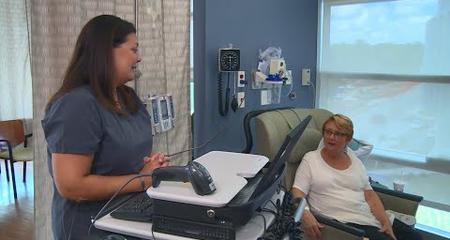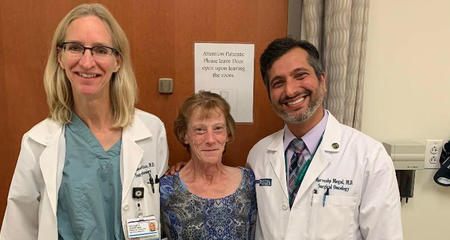 Not only are sarcomas rare, they are also highly diverse. About 25 major categories of sarcomas exist. In addition, there are more than 60 different sub-types of cancerous tissue. Since one sarcoma can behave differently from another, each requires a distinct approach to treatment. Caring for hundreds of patients every year, the Sarcoma Program has the experience and resources to deliver individualized treatments. The interdisciplinary team understands the intricacies of these diseases, and is skilled in the most advanced therapies.
Not only are sarcomas rare, they are also highly diverse. About 25 major categories of sarcomas exist. In addition, there are more than 60 different sub-types of cancerous tissue. Since one sarcoma can behave differently from another, each requires a distinct approach to treatment. Caring for hundreds of patients every year, the Sarcoma Program has the experience and resources to deliver individualized treatments. The interdisciplinary team understands the intricacies of these diseases, and is skilled in the most advanced therapies.
Because these cancer types are very complex, it may be easiest to think of them in terms of bone or soft tissue sarcomas. For both categories of sarcoma, the following are critical considerations within each patient's treatment plan:
In addition combination treatments are important considerations for cancers that have metastasized (spread).
Plastic Surgery to Replace Tissue
After a patient has had surgery to remove a sarcoma, plastic surgeons use specialized surgical techniques to replace tissue and close the surgical wound.
The goal of plastic surgery is to restore the most natural appearance and functioning of soft tissues (skin, fat, blood vessels and nerves). The plastic surgeon may use tissue from other areas of the body to provide natural coverage of exposed artificial joints, bones, blood vessels and nerves. The donor tissue may come from the abdomen, thigh or back. When possible, surgery to remove the cancer and reconstructive surgery are performed in a single operation.
Read more about plastic surgery’s important role in treating sarcomas.
Image-Guided Therapies (Vascular and Interventional Radiology)
Vascular and interventional radiology offers several cutting edge, image-guided therapies to improve outcomes and quality of life for sarcoma patients. These treatments, all of which are usually performed in an outpatient setting, can be used to reduce symptoms of pain and swelling associated with tumors that cannot be removed.
- Sarcomas require a significant amount of blood flow to survive. Embolization is a minimally invasive treatment that stops blood flow to the tumor. It can be performed immediately before surgery, allowing faster, safer removal of the tumor with less blood loss – and an easier recovery.
- Ablation therapy, such as radiofrequency ablation and cryoablation, uses extreme heat or cold energy to destroy tumor tissue, control symptoms and shrink a tumor.
- When bones are weakened by a sarcoma, they can be reinforced through traditional surgical methods or a less invasive method that uses acrylic bone cement.
Combination Treatments
For many patients, the most effective treatment plan includes some combination of surgical, medical, interventional and radiation therapies. The physicians in our program are completely up to date on the most effective combination therapies for different types of sarcoma and the best ways to coordinate these treatments.
Spine Tumors
Many treatment options are available for patients with spine tumors. Our multidisciplinary group of musculoskeletal tumor specialists meets weekly to discuss patients and ensure that an individualized plan for each patient is determined to optimize outcome.
Virtual Visits Are Available
Safe and convenient virtual visits by video let you get the care you need via a mobile device, tablet or computer wherever you are. We’ll gather your medical records for you and get our experts’ input so we can offer treatment options without an in-person visit. To schedule a virtual visit, call 1-866-680-0505.
More to Explore





